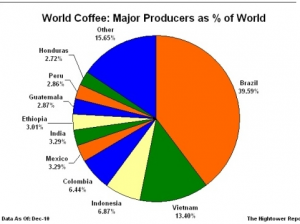I am definitely one of those people who can’t begin their day until they’ve had a cup of coffee. So, I decided that it would be appropriate as the first thing to look deeper into.
Did you know that, next to oil, coffee is the second most traded commodity on worldwide markets? It is also grown in more than 80 countries and employs roughly 20 million farmers! (1) Clearly this is a huge industry. However, something that is worthy to point out is that the countries that produce coffee beans are not the largest consumers of it. Here is a chart which shows the largest coffee producing countries in the world:
This is in contrast to the largest coffee consuming countries: the European Union (35%), the United States (25%), and Japan (9%)(1). Obviously, because of such large transport distances, the environmental footprint of my coffee-drinking habit goes way up.
My coffee of choice is usually Starbucks and so I decided to take a look to see if I could could find any information on the origin and processing of their coffee beans. I found the following video which points towards both the huge amount of human labour and energy costs associated with coffee production:
Satrbucks Coffee: Growing, Processing, Roasting
Not only does the transport globally of coffee involve tremendous amounts of oil but the actual coffee processing has high energy costs associated with it as well. I found this article discussing the energy burden of processing coffee in Costa Rica and new technologies that can be implemented to reduce these costs. In the article, the author suggests that 25 405 000 kWh and 142 268 cubic meters of fire wood are used annually for coffee drying and processing. This electrical energy is enough to power a Costa Rican community of 13 000 people for an entire year (2).
Obviously, although the coffee industry is a huge global industry, it does not run as energy-efficiently as it probably could. Huge transportation distances, coupled with the high energy costs of coffee bean processing require large amounts of oil. With so many people indulging their caffeine habit on a daily basis, it is important to recognize where our coffee is coming from and how much energy is used in its production.
References:
(1) Starbucks Coffee Company. http://mba.tuck.dartmouth.edu/pdf/2002-1-0023.pdf. Accessed Feb. 28, 2012.
(2) Chavez, Victor Julio et. al. Measuring and Managing the Environmental Cost of Coffee Production in Latin America. http://www.conservationandsociety.org/article.asp?issn=0972-4923;year=2009;volume=7;issue=2;spage=141;epage=144;aulast=Arce. Accessed Feb. 28, 2012.
Image Taken from: http://seekingalpha.com/article/294328-coffee-despite-brazilian-frost-colombian-weather-bearish-market-may-be-ahead
Tags: No Comments


0 responses so far ↓
There are no comments yet...Kick things off by filling out the form below.